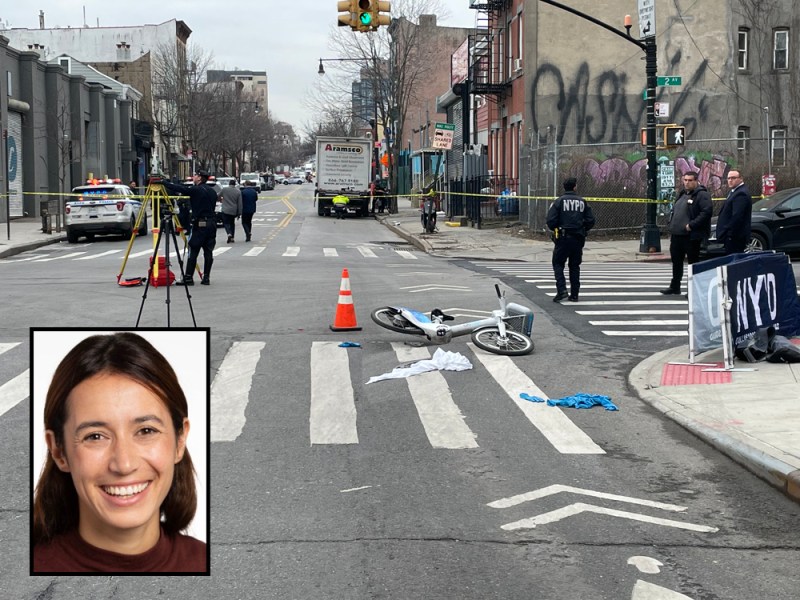DOT Unveils ‘Concepts’ For Deadly Ninth Street, But Advocates Want Something Bolder

The Department of Transportation will finally add a protected bike lane to a dangerous strip of Ninth Street in Park Slope that it had left out of a previous redesign despite its well-known danger — a decision that some believe led to the death of Citi Bike rider Sarah Schick in January.
DOT’s initial concept, unveiled on Wednesday night, would remove parking on the block between Second and Third avenues to make room for a five-foot buffer-protected bike lane in each direction. The protected bike lanes would continue west of Second Avenue to Smith Street — where today the strip has green-painted bike lanes without any protection or separation from traffic, officials said during an in-person “community visioning session.”
Meeting attendees cheered the proposed removal of an entire block of parking spots, which DOT explained was necessary to make room for safe cycling.
“It’s only 35 feet wide, so choices have to be made about what’s going to fit into this space,” said Preston Johnson, DOT’s project manager for the corridor. “What we want to do is be able to put protected bike lanes on both sections, and that of course requires removing some parking between Second and Third avenues.”

DOT also wants to remove 10-foot left turn lanes from the intersection to make room for the protected bike lanes — which, Johnson said, may eventually lead to DOT banning left turns along the corridor if the lack of turning lanes causes too much congestion.
“We might have to consider turn bans if our traffic modeling suggests that it’s not going to work just by allowing vehicles to turn without a turn lane,” he told attendees.

The design presented on Wednesday was preliminary, with the actual plan for the strip to be presented to Brooklyn Community Board 6 next month.
Schick died Jan. 10 when a truck driver struck her as she biked east on Ninth Street — the sixth person to die on Ninth Street in 18 years.
In 2004, 11-year-old Victor Flores and 10-year-old Juan Angel Estrada were struck and killed by a trucker on Ninth Street at Third Avenue, while walking home from school. Fourteen years later, Dorothy Bruns hit and killed 1-year-old Joshua Lew and 4-year-old Abigail Blumenstein. Blumenstein’s mother, actress Ruthie Ann Miles, who was injured in the crash, also later lost her unborn child.
That crash led to the installation of a protected bike lane between Prospect Park West and Third Avenue despite calls for two more blocks of protection. Schick’s family members and their attorney have said her death could have been prevented if DOT had followed through on redesigning the entirety of Ninth Street in 2019.
“They knew and did nothing,” Schick’s widowed husband Maxime Le Munier said in February as he announced a $100 million lawsuit against the city for the crash. “They have a responsibility in Sarah’s death and the previous deaths as well, and it needs to change.”
Local bike and safety advocates still believe the street is in need of a radical redesign. On Wednesday, they floated more robust changes to the thoroughfare, such as converting Ninth Street into a one-way corridor. DOT put the kibosh on that idea, for now — saying it’s too complicated because the roadway is both a truck and bus route for the B61. Pols and advocates are currently calling on the city to re-evaluate the city’s designated truck routes, DOT Brooklyn Borough Commissioner Keith Bray said.
“That’s something actually to consider and follow up on, but that’s not a 2023 possibility,” Bray said.
The city needs to think more boldly, said Transportation Alternatives Brooklyn Organizer Kathy Park Price.
“In 2018, I’ll just note that I felt that we were not doing enough …we should have gone further as a neighborhood,” she said. “We did the bare minimum. And while the protected bike lane on Ninth Street in Park Slope has improved safety, we should have looked at the whole corridor. I also tonight feel like we can and should do more.”
9th St. community/visioning meeting hosted by @ShahanaFromBK and @NYC_DOT getting underway at @van_alen 303 Bond at Union. Until 8:30. Join us. pic.twitter.com/2biio38oQH
— Kathy Park Price (@KathyParkPrice) April 26, 2023
The council member who represents the area agreed that the protected bike lane is a good, urgent first step — but said the city can’t stop there.
“We heard suggestions to study this corridor and the trends around trucking, so there’s work that the DOT will need to do to actually deliver, but having a protected bike lane between Second and Third is imperative,” Council Member Shahana Hanif (D-Gowanus) told Streetsblog on Thursday.
“They gave us an unfinished bike lane the first time around so I would say getting this bike lane done protected bike lane done is the first step towards a more serious look at this corridor.”





